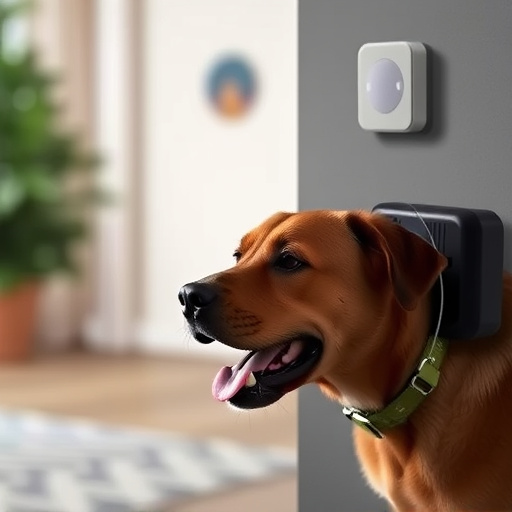Wireless alarm systems, featuring advanced motion sensors and specialized “barking dog alarms,” offer modern, convenient home security solutions. These systems employ passive infrared (PIR) technology to detect unauthorized entry through movement, temperature changes, or vibrations, minimizing false alarms even in the presence of pets. The barking dog alarm uses AI to differentiate between animal behavior and potential intruders, providing 24/7 protection for properties from both four-legged and human visitors. Easy installation, flexible coverage, and comprehensive protection make wireless alarm systems, particularly those with motion sensor barking dog alarms, an effective choice for homeowners seeking enhanced security.
“Discover the power of wireless alarm systems – a modern security game-changer. This comprehensive guide explores how these innovative solutions protect your home. From understanding the basics to delving into advanced features, we cover it all. Learn about motion sensors and their critical role in outdoor detection, even integrating a barking dog alarm for enhanced vigilance. Benefits of wireless setups are highlighted, along with practical installation and maintenance tips. Arm yourself with knowledge – literally.”
Understanding Wireless Alarm Systems: The Basics
Wireless alarm systems have revolutionized home security, offering a modern and convenient solution for homeowners. At their core, these systems rely on various components that work together to protect your property. One key element is the motion sensor, which plays a vital role in detecting unauthorized entry. These sensors are often triggered by movement, changes in temperature, or even vibrations, alerting you to potential intruders.
For pet owners, a unique challenge arises when considering wireless alarm systems, especially with noisy pets like barking dogs. However, advanced technology has addressed this concern through specialized motion sensors designed to differentiate between human movement and animal behavior. These sensors can learn patterns and minimize false alarms caused by pets, ensuring your peace of mind without constant interruptions.
Motion Sensors: How They Work and Their Role in Security
Motion sensors are a critical component of modern wireless alarm systems, playing a pivotal role in enhancing home security. These devices are designed to detect any movement or intrusion within a defined area, triggering an alert that can deter potential thieves and notify homeowners or security services. One of the most common types of motion sensor is the passive infrared (PIR) sensor, which uses infrared light to create a grid of invisible beams across a room or outdoor space. When an object, such as a person or a barking dog, crosses these beams, the sensor detects the change in temperature and sends a signal to the alarm control panel, prompting it to sound the alarm.
The integration of motion sensors into wireless alarm systems offers numerous advantages. They provide 24/7 monitoring, allowing for immediate response to any suspicious activity. Unlike traditional alarms that rely solely on breakable glass or magnetic contacts, motion sensors can detect even subtle changes in an environment, reducing false alarms while ensuring a swift reaction to genuine security breaches. Moreover, the barking dog alarm feature is particularly useful, as it distinguishes between animal behavior and potential intruders, minimizing unnecessary alerts and giving homeowners peace of mind.
Integrating a Barking Dog Alarm: Enhancing Outdoor Detection
Integrating a barking dog alarm into your wireless security system can significantly enhance outdoor detection, especially in areas prone to wildlife or stray animal intrusion. This innovative device leverages the power of motion sensors and artificial intelligence to differentiate between potential threats and false alarms. By analyzing movement patterns, it can accurately detect animals like deer, rabbits, or even intruding humans, ensuring a more reliable security network around your property.
The barking dog alarm acts as a game-changer for outdoor surveillance. When triggered, it not only emits a loud, intimidating bark but also sends instant alerts to your smartphone, allowing you to take immediate action. This dual functionality makes it an effective deterrent and provides peace of mind, knowing that your home is protected 24/7 from unexpected visitors, both four-legged and human.
Benefits of a Wireless Setup for Home Security
A wireless alarm system offers numerous advantages for homeowners seeking enhanced security, particularly with features like motion sensors and barking dog alarms. One of the key benefits is its flexibility and convenience; since there’s no need to run wires throughout your home, installation is quick, easy, and less disruptive compared to traditional wired systems. This makes it an attractive option for renters or those planning to move frequently.
Moreover, wireless setups provide better coverage and peace of mind. Motion sensors can be strategically placed to monitor various entry points, including windows, doors, and even outdoor areas, ensuring comprehensive protection. For pet owners, a barking dog alarm can distinguish between genuine threats and friendly visitors, reducing false alarms while still alerting you to potential dangers. This level of customization and responsiveness contributes significantly to the overall security and safety of your home.
Installation, Maintenance, and Troubleshooting Tips
Setting up a wireless alarm system, like a motion sensor barking dog alarm, is often a straightforward process that can be completed with minimal technical expertise. Most systems come with detailed installation manuals and all necessary components. Start by placing the motion sensors in strategic locations around your property, ensuring they have line-of-sight to areas you want to protect. Then, connect each sensor to the control panel according to the instructions provided. Once installed, test the system immediately to verify its functionality.
Regular maintenance is key to keeping your wireless alarm system running smoothly. This includes testing sensors monthly and replacing batteries as needed. Keep an eye on the control panel’s backlight and make sure it’s functional. If you encounter any issues, refer to the system’s user manual or contact customer support for troubleshooting guidance. Common problems include sensor false triggers (often due to pet movement), power outages, or low battery signals. Prompt action on these issues can help prevent security breaches and ensure your peace of mind.
